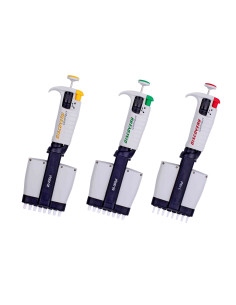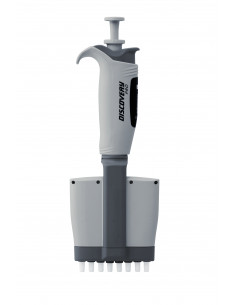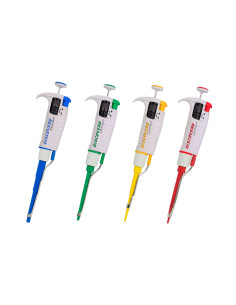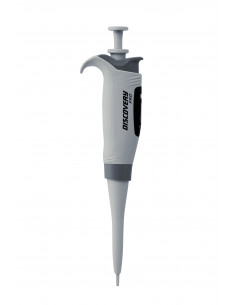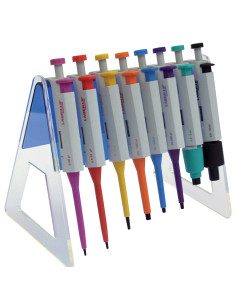Micropipettes are essential tools in any laboratory, as they allow for the measurement and transfer of small volumes of liquid with high precision. To use them correctly and maintain their efficiency, it's essential to understand the parts of a micropipette, their specific functions, and how to care for them properly. In this complete guide, we explain each component and its importance in ensuring accurate and safe pipetting.
What is a micropipette and why is it important to know its parts?
A micropipette is a laboratory instrument designed to aspirate and dispense very small volumes of liquid, typically in the microliter (µL) range. It is used in various scientific fields such as molecular biology, biochemistry, microbiology, and medicine, among others.
Knowing the parts of a micropipette allows you to:
-
Use it properly according to the type of task.
-
Avoid measurement errors.
-
Perform proper cleaning and maintenance.
-
Extend the life of the equipment.
-
Ensure reproducible and accurate results.
Main components of a micropipette
Below are the most important parts of a micropipette, along with a description of each component’s function:
Plunger or piston
This is the part that is manually operated to aspirate and dispense the liquid. Pressing the plunger creates negative pressure that allows the liquid to be drawn in when released. Pressing it again expels the contents from the tip.
Volume control knob
This knob allows you to adjust the desired volume before pipetting. By rotating it, you change the position of the piston, thus limiting the amount of liquid that can be aspirated.
Volume display window
A small screen or indicator that shows the selected volume in real-time. Proper reading is key to avoid measurement errors.
Body or casing
The outer structure that protects the internal mechanism. It is usually made of durable plastic or composite materials. Its ergonomic design facilitates prolonged use without causing hand fatigue.
Nozzle or tip cone
The lower part where disposable tips are attached. A firm fit is necessary to avoid leaks and ensure accuracy. Some micropipettes feature universal cones compatible with most tips on the market.
Tip ejector
A mechanism that allows you to discard the used tip without touching it, reducing the risk of cross-contamination and improving workflow efficiency.
Differences in parts depending on the type of micropipette
While all micropipettes share basic components, there are important differences depending on their type:
-
Manual micropipettes: Operated by direct pressure on the plunger. They typically have a simple and durable design.
-
Electronic micropipettes: Include a motor and digital controls to adjust the volume and dispense liquid automatically.
-
Single-channel micropipettes: Have one nozzle, ideal for individual tasks requiring high precision.
-
Multichannel micropipettes: Have several nozzles (usually 8 or 12), allowing for simultaneous pipetting into microplates and processing multiple samples at once.
Importance of maintaining each part of the micropipette
Proper maintenance is crucial for preserving accuracy and extending the instrument’s lifespan. Here are some component-specific tips:
-
Plunger: Clean regularly with isopropyl alcohol and lubricate if needed.
-
Nozzle: Check for liquid residue or broken tips.
-
Volume window: Ensure the display is clear and unobstructed.
-
Tip ejector: Make sure it works smoothly to prevent jamming.
-
Body: Wipe with a damp cloth and avoid impacts or drops.
Additionally, it’s recommended to calibrate the micropipette every 3 to 6 months, depending on usage.
Find quality micropipettes at Pobel
At Pobel, we offer a wide variety of manual, electronic, single-channel, and multichannel micropipettes, all with guaranteed quality and precision. We also provide personalized guidance to help you choose the model that best fits your laboratory needs.
✔ We work with leading brands in the sector.
✔ Fast and secure shipping.
✔ Competitive prices and options for all budgets.
Browse our catalog today and upgrade your lab with the best equipment.
Frequently Asked Questions
How do you clean each part of a micropipette?
Basic cleaning involves disinfecting the exterior with isopropyl alcohol and disassembling the internal parts (if the model allows) to remove any residue. Some parts can be sterilized in an autoclave.
What should I do if a micropipette loses precision?
First, check for blockages in the nozzle or wear on the plunger. If the issue persists, it’s advisable to recalibrate or contact the supplier.
How often should a micropipette be calibrated?
It is recommended to calibrate it every 3 to 6 months, depending on how often it's used and the type of samples being handled.



